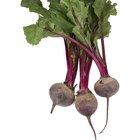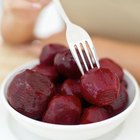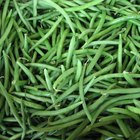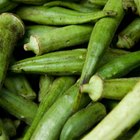
eye-blink/iStock/Getty Images
Blanching can help you preserve the bounty of okra if you love it, or improve its overall texture and flavor if you're trying to love it. Popular in the South, okra is beloved for its fresh flavor. Unfortunately, its slimy texture can be off-putting to many people. Lose the slime and prepare this green veggie for freezing by blanching it, a fast cooking method that requires minimal time but is well worth the effort.
The Basic Blanching Process
To blanch okra, fill a large pot with water and bring it to a boil over high heat, while filling a large bowl with ice and water. Once the water in the pot starts boiling, add approximately 2 to 4 tablespoons of salt. Although salt is an optional ingredient, it does help preserve the okra's green color. Stir the salted water to dissolve the salt and then add the okra.
Begin timing the blanching process once the water comes back to a boil. Boil small okra pods for 3 minutes, allowing 4 minutes for larger pods. Drain the boiling water and immediately place the okra in the bowl of ice water to halt the cooking process. Once the okra pods are cool, drain them from the ice water and allow them to dry on a clean kitchen towel or a plate lined with paper towels. If you're blanching a large volume of okra, plan to change the boiling water and ice water frequently to eliminate sliminess.
Why Blanch Okra
The main reason to blanch okra is in preparation for canning or freezing it to preserve its summer-fresh flavor for year-round use. The blanching process halts enzymatic actions that cause the okra to lose texture, color and flavor while preserving its vitamin content and cleansing the surface of the pods of dirt and other organisms.
The short cooking time and high heat used to blanch okra is also a useful tool for preparing fresh okra to use in a recipe. Blanching helps reduce okra's characteristic sliminess by halting the pods from releasing naturally occurring mucilage, a substance also found in aloe plants. Blanch the okra and pat it dry before freezing it or adding it to your dish.
Choosing and Prepping the Pods
Whenever possible, select firm, young okra pods that have a velvet green color and a crisp, snappy texture. According to the book, Fine Cooking In Season, the optimal okra pods measure 2 to 4 inches and lack any noticeable shriveling.
Blanch fresh okra as soon as possible for the best results. If necessary, store fresh okra for up to 2 or 3 days in the vegetable crisper of your refrigerator. Wash the pods under fresh, cold water before trimming the stems.
Using Blanched Okra
If you're freezing the okra, allow the pods to dry completely after you blanch it. You can leave the blanched okra whole, or slice the pods into coins. Arrange the okra in a single, even layer on a baking sheet and place the baking sheet in the freezer, uncovered. When the okra is frozen, transfer it to a resealable plastic bag or an airtight container. By freezing the okra on the baking sheet first, you avoid ending up with frozen clumps, so you can remove a little at a time.
Alternatively, you can add the blanched okra directly to your recipe. Slice the okra to throw in gumbo, soups or stews. Leave the pods whole to char on the grill or under the broiler. You can use blanched okra any way you choose, but avoid overcooking it, which can create an unpleasant texture.
Related Articles

How to Freeze Broccoli

How to Eliminate Bitterness in Broccoli

How to Freeze Cut Okra

How to Freeze Fresh Beets

How to Remove a Cardamom Seed From a Pod

How to Dehydrate Okra

How to Tell When Okra Is Ripe

How to Freeze Fresh Asparagus

How to Tell if Okra Is Spoiled

How Do I Reduce the Slime When Cooking ...
How to Clean and Cook Broccoli Rabe

How to Freeze Romanesco

How to Boil Beetroot
How to Preserve Kohlrabi

How to Blanch Green Beans for Freezing

How to Blanch, Peel, & Freeze Whole ...

How to Freeze Raw Zucchini

How to Cook Manioc Root

Can I Freeze Large Zucchini and Summer ...

How Long Does Fresh Whole Okra Take to ...
References
Writer Bio
Caryn Anderson combines extensive behind-the-scenes writing experience with her passion for all things food, fashion, garden and travel. Bitten by the travel bug at the age of 15 after a trip to Europe, Anderson fostered her love of style and fashion while living in New York City and earning her degree at New York University.
Photo Credits
eye-blink/iStock/Getty Images